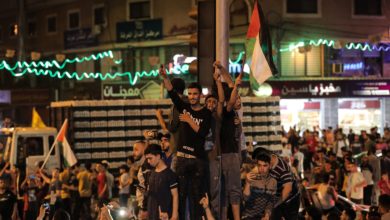The U.S. military, aided by its Iraqi client state, continues its campaign against the Mahdi Army. The attacks on the 60,000 strong militia loyal to Shiite cleric Moqtada al-Sadr started in late March when Prime Minister Nuri al-Maliki announced that he would go after all militias and “criminal elements.”
|
The Mahdi Army has since played a contradictory role. It has been in a quasi-alliance with the U.S. government and has participated in the ruling government coalition. Moreover, it has taken part in the killings of Sunnis, in line with the U.S. strategy of dividing the population.
At the same time, with grassroots support from the urban poor Shia population, Sadr and his army have expressed their opposition to the occupation in various forms, including demonstrations.
Shortly after the crackdown started, President Bush voiced his admiration for Maliki. On a trip to Iraq on April 20, Secretary of State Condoleezza Rice expressed support by saying: “There are those who questioned whether or not the prime minister was prepared to go after militias that were associated one way or another with political elements in his coalition … and there have been questions from the Arab states… I think he’s answering that question.”
There is little doubt that the decision to go after the Mahdi Army was not Maliki’s. The Iraqi military is formed, funded, trained and armed by the United States, with U.S. military personnel embedded at numerous levels. Today, as U.S. officials desperately attempts to create a client state that vaguely resembles a real government, it needs to rein in the Mahdi Army. Pentagon officials would much rather have Iraq’s military take the initiative so Iraqis take the casualties while Washington portrays the conflict as an internal Iraqi affair.
However, once the initial phase of the crackdown resulted in large-scale desertions by Iraqi military personnel, U.S. occupation forces unleashed aerial bombings and stepped in on the ground.
On April 19, after weeks of fighting, Sadr threatened an all-out war. He later clarified his statement: “When we threatened an open war, it was meant against the occupation and not against our people … there will be no war between Sadrists and Iraqi brothers from any groups.”
Putting the spotlight on the government’s service to the occupiers, Sadr stated: “We want a government which is sovereign, and we reject any agreement between America and the Iraqi government. I urge the Iraqi army to be close to the people and far from the occupier.”
No safe haven
The situation has taken on a new urgency for U.S. forces in Iraq. The U.S. military experienced its largest death toll in seven months in April, with 52 troops killed—roughly half of them in Baghdad. Despite Sadr’s intent to prevent an escalation, fighting has been intense and unrelenting since March 25. After five years of occupation, the U.S. military has been unable to control Iraq and defeat Iraqi resistance. However, it had managed to protect Baghdad’s highly fortified “Green Zone.”
This is no longer the case. Quoting U.S. and Iraqi military officials, an April 28 Newsweek article reports: “Of about 700 rockets and mortar rounds fired since March 23, about 120 struck the Zone.” These rockets have taken the lives of U.S. military personnel and others. More significantly, they have had a significant psychological effect in that they have removed the safe haven the occupiers used to enjoy.
The Green Zone houses numerous embassies—including the nearly completed U.S. embassy, the largest embassy in history. U.S. diplomats, who are really the administrators of the recolonized Iraq, as well as military officers, heads of the U.S. contractors and the Iraqi client-state officials operate inside the Green Zone. It was the one area in Iraq where the occupiers and their collaborators thought they were safe.
Trying desperately to protect the Green Zone, the U.S. military has started the construction of a wall dividing the northern and southern sections of the Sadr City neighborhood. While Iraqis only have electricity for an average of four hours a day, construction work goes on day and night. Like the wall Israel has built in Palestine’s West Bank and the wall the Bush administration is building on the U.S.-Mexico border, walls and barriers have become a common imperialist tool for spreading “democracy.”
Ruling class critics of the Bush administration are, once again, expressing frustration at the lack of sufficiently trained Iraqi military personnel, forcing the American military to do most of the fighting. But when fighting units abandon their posts, desert or join the other side in large numbers, the problem is not lack of training.
Having fought an eight-year war against Iran and two wars against the United States and its allies, Iraqis have more than their share of battle-tested fighters. However, the Iraqi military under the command of the occupation forces lacks the resolve to fight against its own people. No amount of training will get Iraqi soldiers to fight effectively when the population is overwhelmingly opposed to the occupation.
Whatever the outcome of the current campaign against the Mahdi Army, which is yet to be determined, Washington is no closer to pacifying the Iraqi population. To the lament of the occupiers, resistance to the occupation has and will continue in a multitude of forms.






